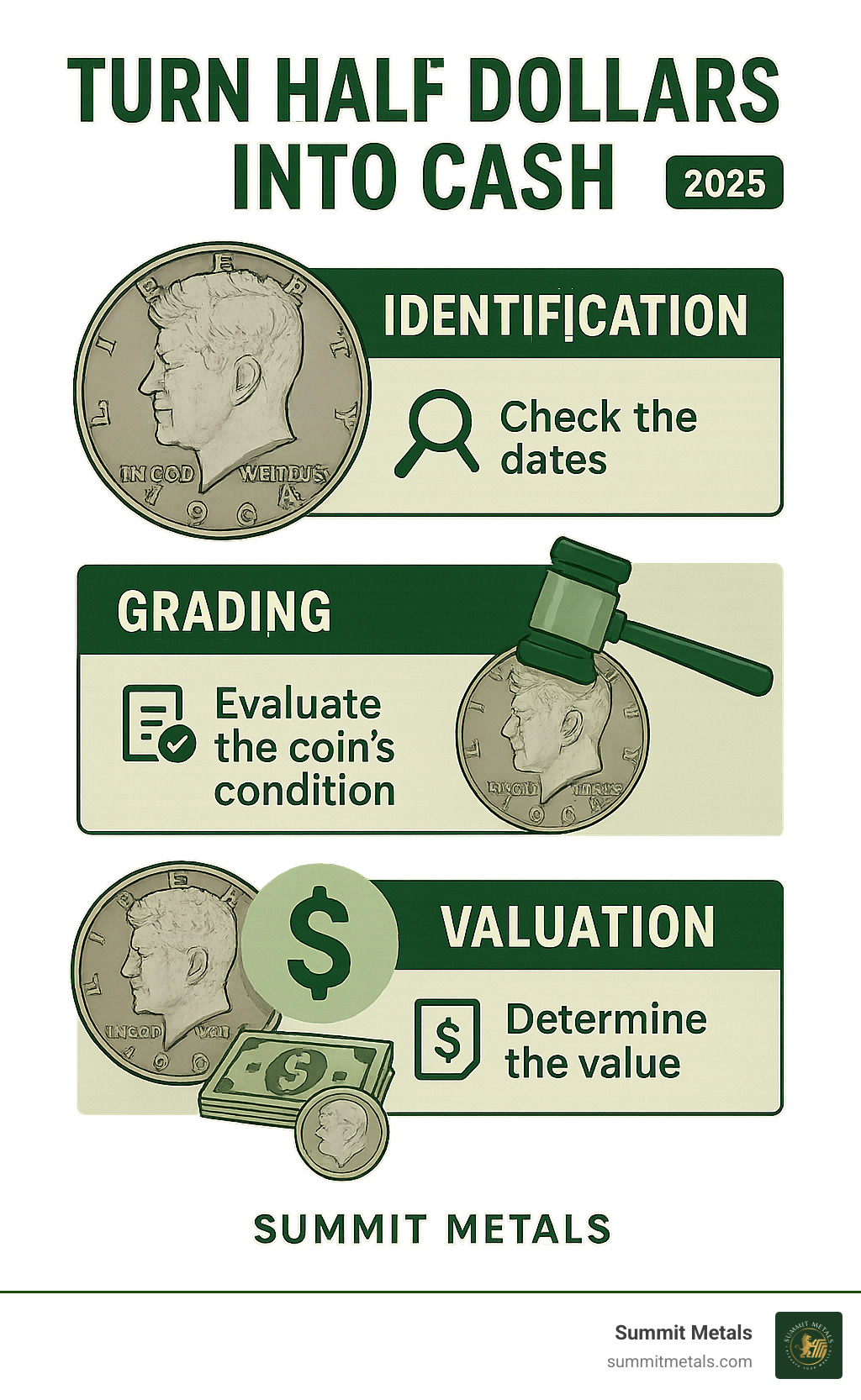Why Half Dollar Coin Value Matters for Your Financial Future
Most half dollars are still only worth fifty cents in change, yet the right coin can fetch hundreds—or even thousands—of dollars. Knowing what makes the difference is an easy way to turn forgotten pocket change into real money.
Quick Value Check
- 1964 & earlier: 90 % silver – $10 + each
- 1965-1970: 40 % silver – $3-8 each
- 1971-present: clad – usually face value
- Key dates: 1964, 1921-S (Walking Liberty), 1970-D
- Notable errors: $500–$13,000 +
Every U.S. half dollar from 1794-1964 is 90 % silver; coins dated 1965-1970 are 40 % silver; later pieces have no precious-metal content unless struck for special sets. Add in a small list of key dates and a few headline-making mint errors, and you have a recipe for hidden wealth in ordinary change.
I’m Jose Gomez. After a decade in investment banking and precious-metals trading, I’ve learned that a quick eye for silver content and rarity can build—or protect—serious wealth. The short guide below shows you exactly how.
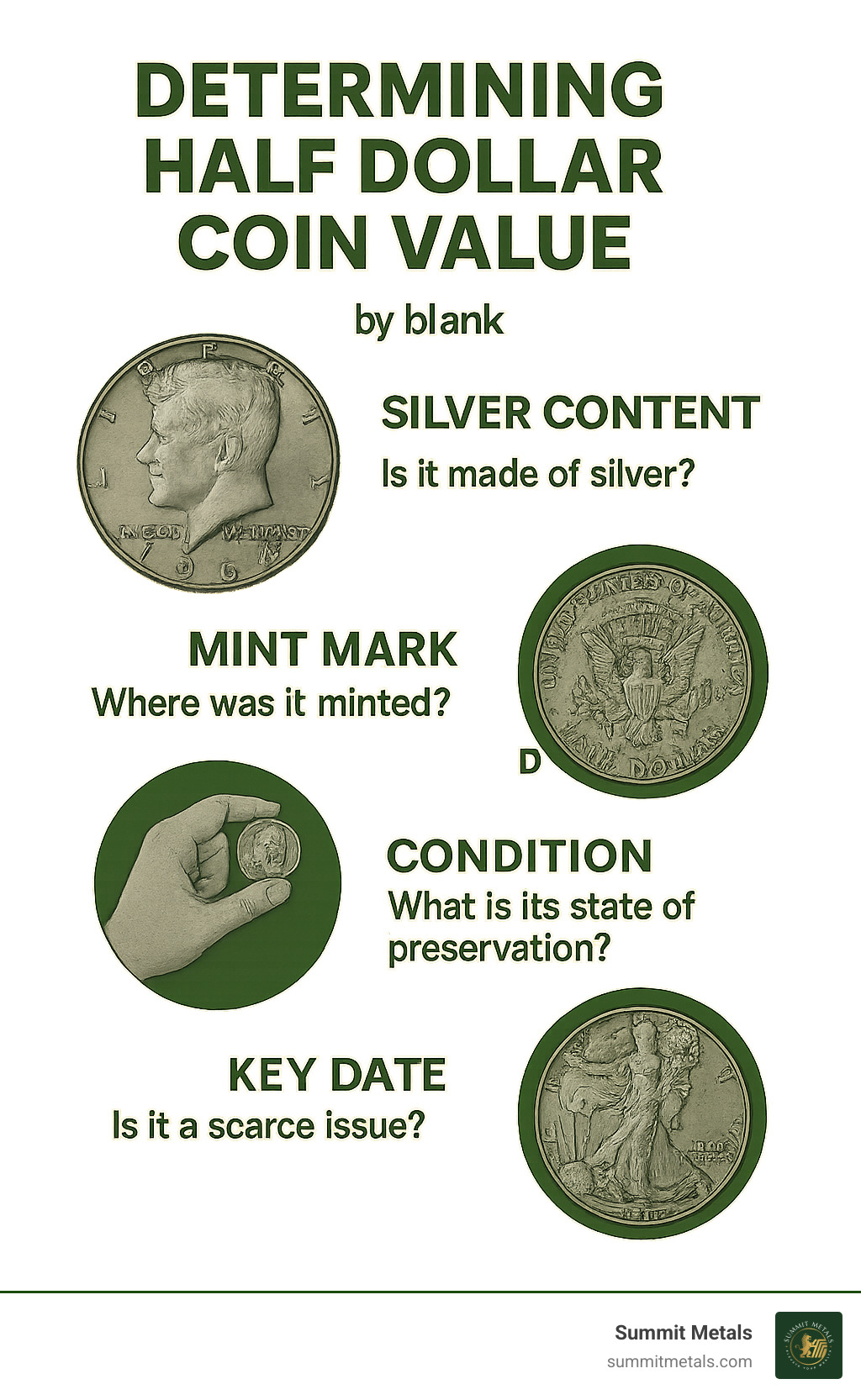
What Determines Half Dollar Coin Value?
A half dollar’s price tag comes down to five variables that work together like gears in a watch:
- Silver content – the built-in melt value.
- Condition/grade – how much wear the coin shows.
- Rarity – low mintage or low survival numbers.
- Collector demand – what people are willing to pay today.
- Historical significance – events or people tied to the design.
Silver is the biggest lever. Even a scratched 1964 Kennedy is worth melt—roughly $19 at today’s silver spot. Condition is next: a 1971 Kennedy worth $0.50 in average circulation rocketed to $3,100 in certified mint-state 67.
Grading follows the 70-point Sheldon scale. The breakpoints to remember:
- Good (G-4): outlines only
- Fine (F-12): clear features, heavy wear
- Very Fine (VF-20): light wear on high points
- Extremely Fine (EF-40): sharp details, slight rub
- About Uncirculated (AU-50): traces of wear
- Mint State (MS-60-70): no circulation wear
Professional grading from PCGS or NGC adds authentication and can multiply resale value.
Rarity isn’t just about how many were struck; it’s how many survived in high grade. Only about 60,000 matte-finish 1998 Kennedys exist—compare that with the 430 million 1964s. Yet both trade at premiums because of silver content or scarcity.
Collector demand ebbs and flows, but coins tied to big moments—like JFK’s assassination—keep perennial interest. Combine that with solid silver and your 50-cent coin suddenly matters a lot more.
Identifying Your Half Dollar: Types, Varieties, and Key Features
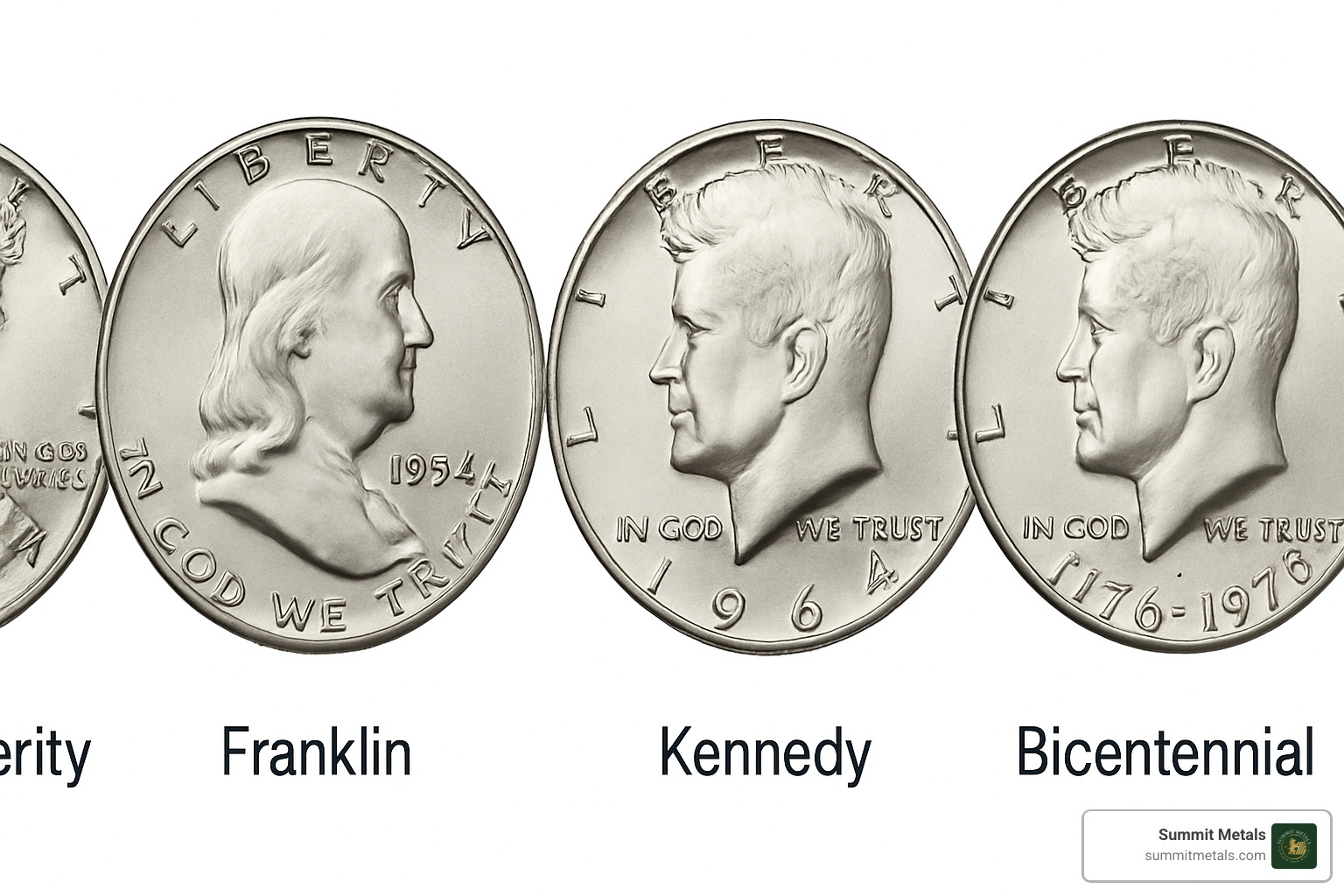
The design on the coin tells you almost everything you need to know.
Main U.S. Half-Dollar Series
- Walking Liberty (1916-1947): 90 % silver, classic Liberty striding design, $10-$8,000.
- Franklin (1948-1963): 90 % silver, Ben Franklin obverse, Liberty Bell reverse, $12-$500.
- Kennedy (1964-present): Silver in 1964 (90 %), 1965-1970 (40 %), clad afterward. Most are face value, but key dates and errors soar.
- Barber (1892-1915): Older 90 % silver coins; worn examples melt for silver, nice ones command strong premiums.
- Bicentennial (dual-dated 1776-1976): Special Independence Hall reverse; common clad pieces circulate, 40 % silver versions come only in collector sets.
Mint Marks Matter
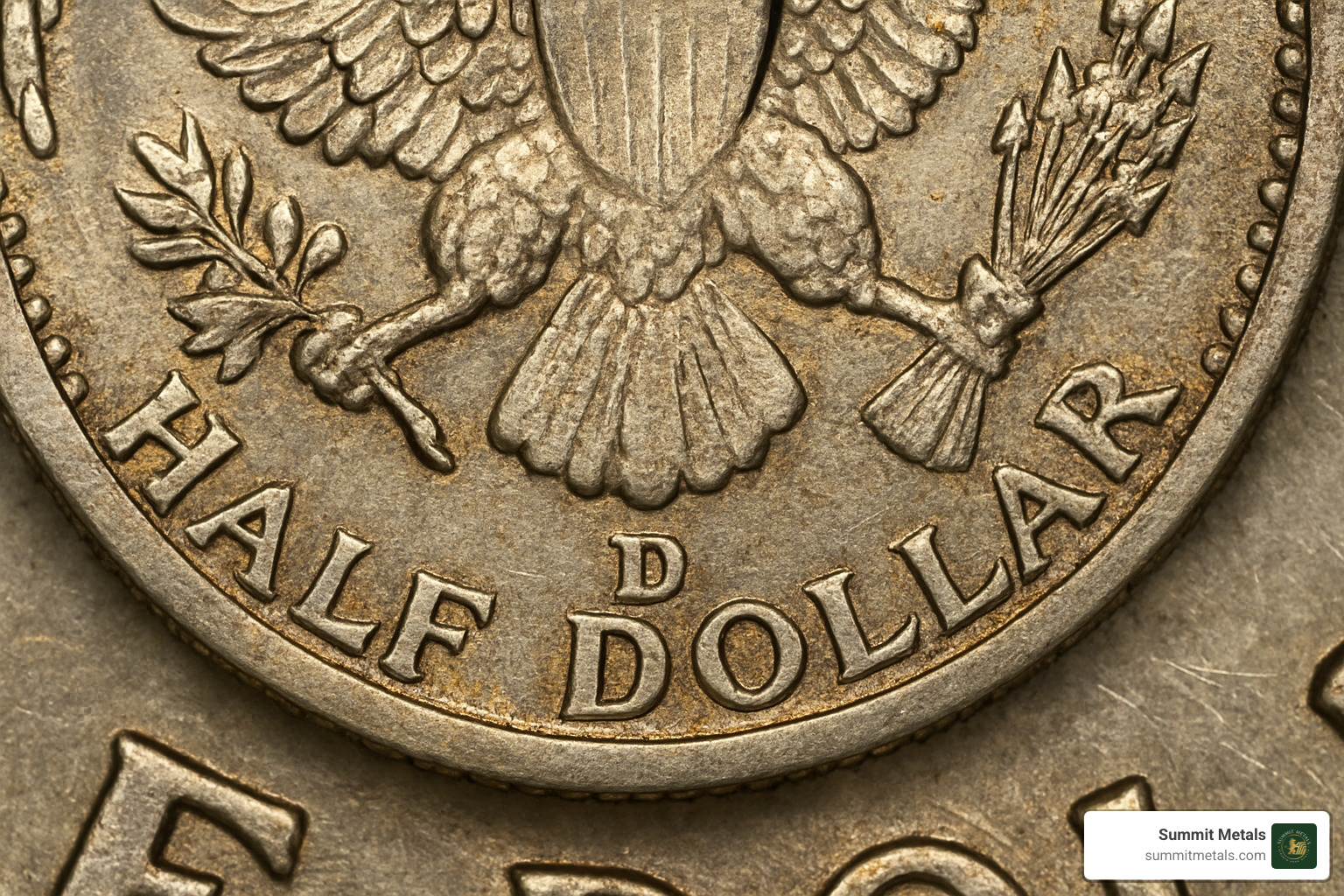
Look below Kennedy’s neck on 1964 coins and just above the date on 1968-present pieces.
- No mark = Philadelphia
- D = Denver
- S = San Francisco (often proofs)
The 1970-D Kennedy appears only in mint sets and commands $100-$300 in average uncirculated condition.
Valuable Varieties & Errors
- 1971-D on 40 % silver planchet: $10,000 +
- 1974-D doubled die obverse: several hundred dollars.
- 1776-1976 doubled INDEPENDENCE HALL: up to $5,000.
- 1998 Matte Finish Kennedy: $100-$500.
Inspect every coin under good light; a single error can beat a whole roll of common dates.
Silver Content and Composition: The Built-In Price Floor
Most half-dollar value debates start—and often end—with silver. From 1794 through 1964 the coins were 90 % silver; from 1965-1970 they were 40 % silver; later pieces are copper-nickel clad unless struck for special collector sets.
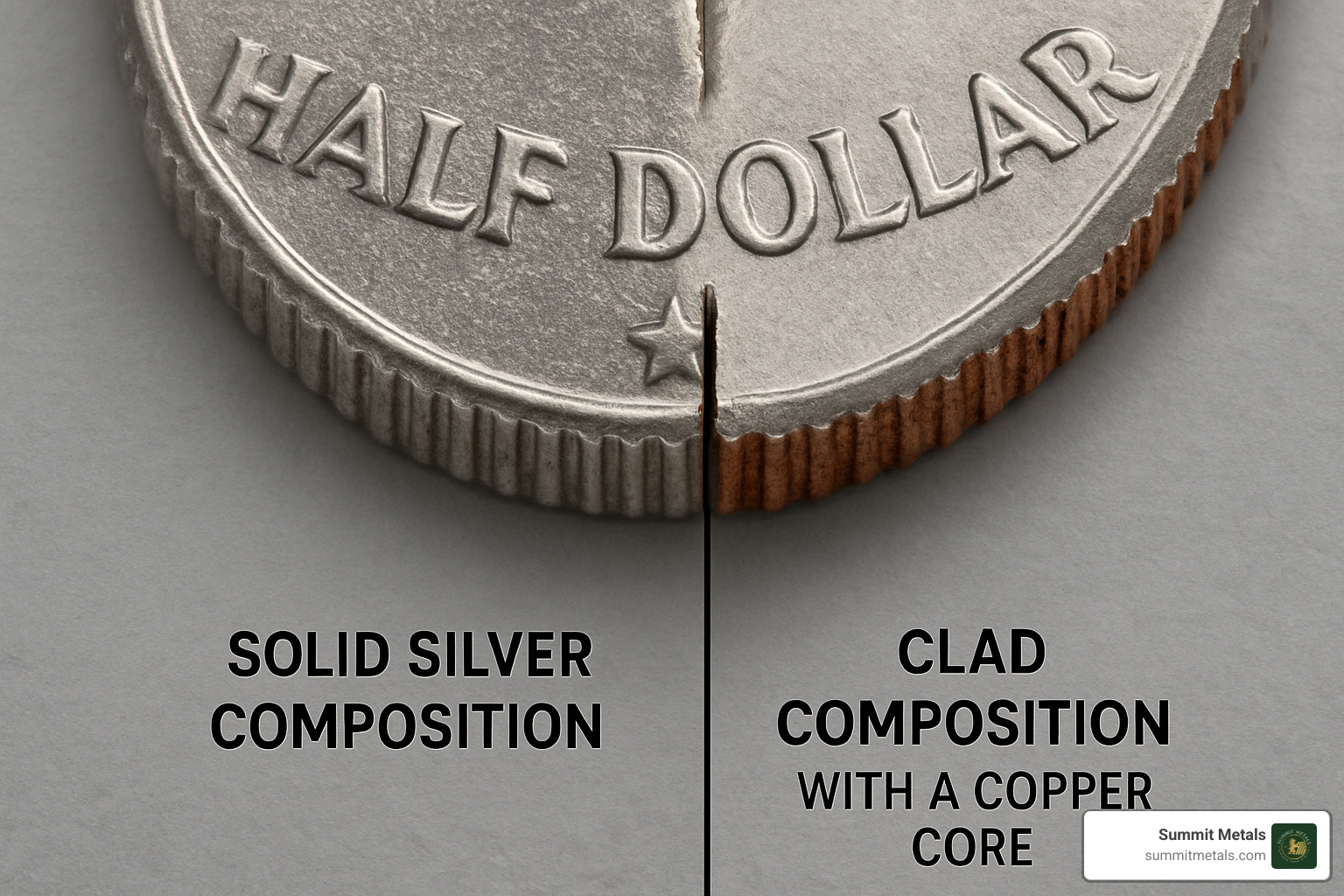
Fast Silver Tests
- Date: 1964 & earlier = 90 % silver; 1965-1970 = 40 % silver.
- Edge: solid silver stripe vs. copper core.
- Weight: 12.5 g (90 %), 11.5 g (40 %), 11.34 g (clad).
- Sound: silver rings; clad thuds.
Melt-Value Math
- 90 % halves: 0.362 oz × spot price.
- 40 % halves: 0.148 oz × spot price.
Because spot price moves daily, silver coins carry a floating but reliable price floor. Current metal quotes are available straight from the London Bullion Market Association, the global reference for precious-metal pricing.
Silver half dollars appeal to both investors and collectors: even if numismatic demand fades, you still own recognized, easily tradable silver.
Special Focus: Bicentennial and Modern Half Dollars
The 1776-1976 Bicentennial Half Dollar holds a special place in American hearts and coin collections. Minted to celebrate our nation's 200th birthday, these coins carry the unique honor of being the only half dollars to feature a dual date and special commemorative design.
When you flip over a Bicentennial half dollar, you'll see Independence Hall instead of the usual presidential seal. This design change, combined with the 1776-1976 dual date, makes these coins instantly recognizable. The interesting thing is that no half dollars were dated just 1975 - the mint skipped that year entirely to focus on the Bicentennial celebration.
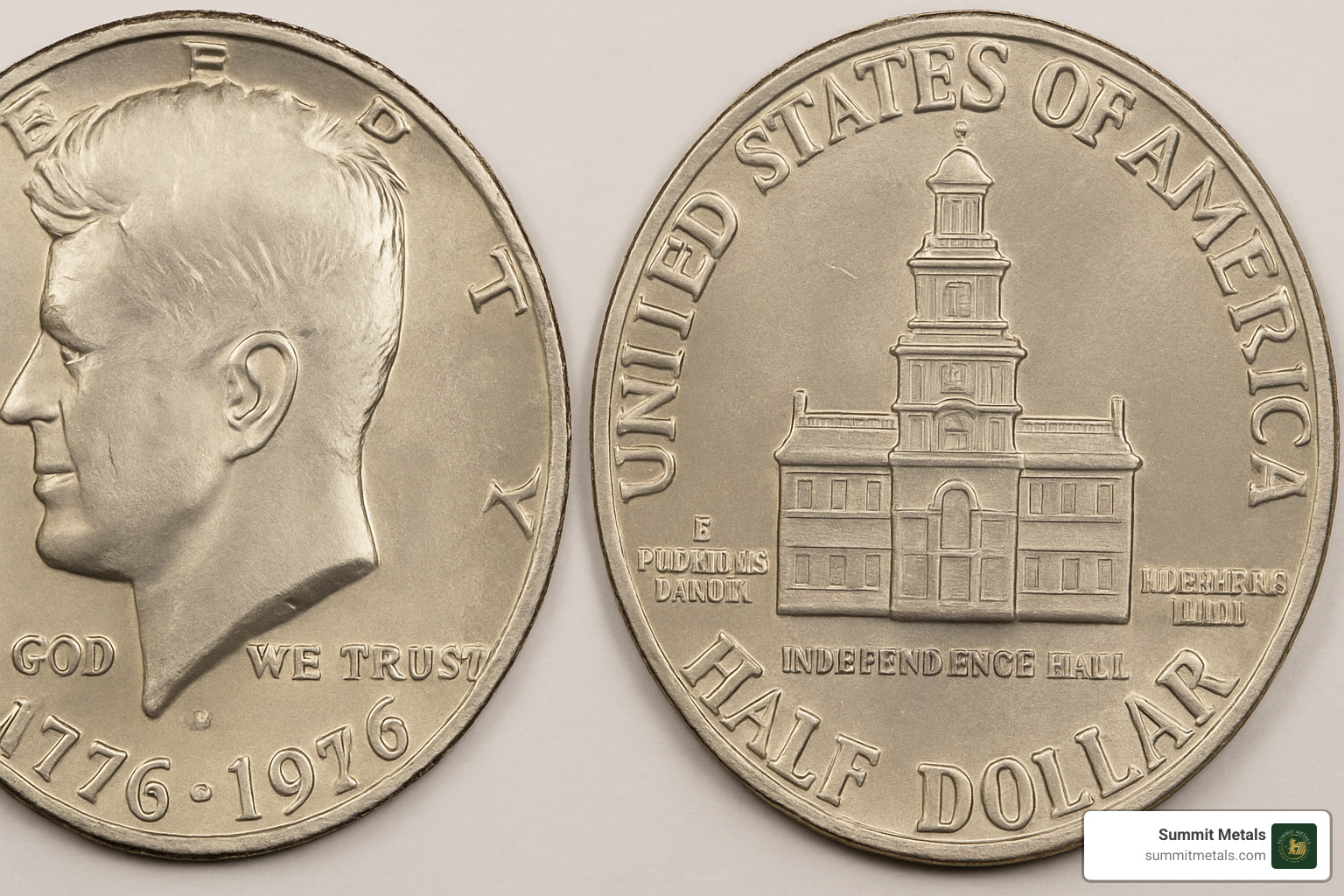
The Bicentennial Half Dollar came in two compositions, which is crucial for determining value. Most were made with the standard copper-nickel clad composition, but special 40% silver versions were struck at the San Francisco Mint exclusively for collector sets. These silver versions are significantly more valuable than their clad counterparts.
What makes some Bicentennial half dollars worth serious money? Error varieties top the list. A Bicentennial half dollar with a doubled die error - where you can see doubling on "INDEPENDENCE HALL" - sold for an impressive $5,200. Another with an off-center strike brought $2,800 at auction. These errors prove that even common coins can hide valuable surprises.
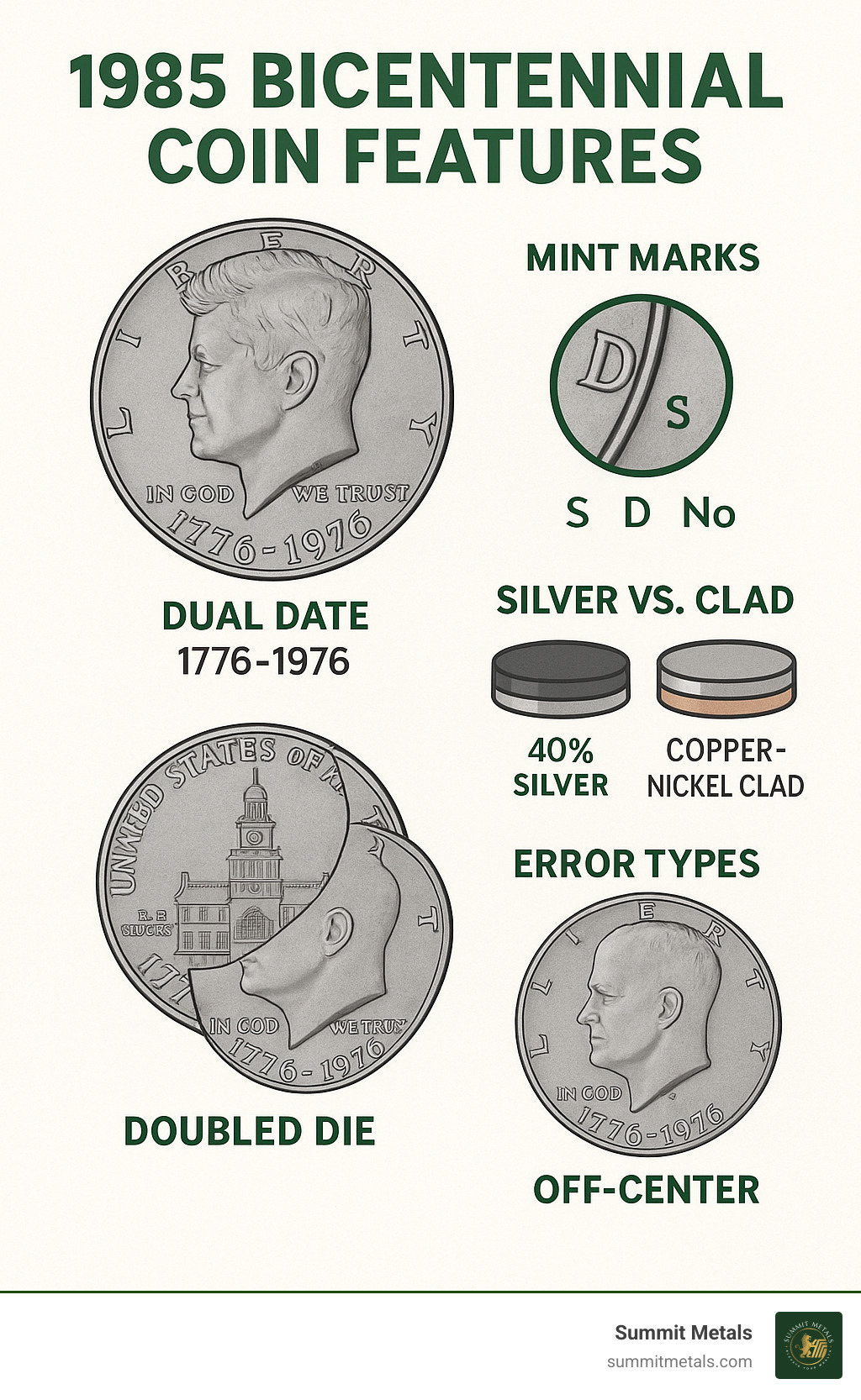
Value Ranges for Bicentennial and Modern Issues
Most Bicentennial half dollars you'll find are worth between 50 cents and $3 if they're the common clad variety that circulated. The half dollar coin value jumps significantly for uncirculated examples, which can range from $1 to $20 depending on their condition.
The real value lies in the 40% silver versions. These special coins, marked with an "S" mint mark, are worth $6 to $50 based on condition and current silver prices. Proof silver versions command even higher prices, typically selling for $20 to $100.
Modern Kennedy half dollars from 1971 onward tell a different story. Most are worth exactly 50 cents, but there are notable exceptions that can surprise you. A 1971 Kennedy half dollar in perfect condition can sell for up to $3,100 - a remarkable premium for a relatively modern coin.
The 1971-D Kennedy half dollar struck on a silver planchet represents one of the most valuable modern errors. When leftover 40% silver planchets from 1970 accidentally got mixed into 1971 production, they created coins worth $10,000 or more today.
Another standout is the 1998 Matte Finish Kennedy half dollar. With only about 60,000 produced, these coins typically sell for $100 to $500. The 2014 50th Anniversary Gold Kennedy half dollar commands $1,000 to $2,000, making it one of the most expensive modern half dollars.
Are Half Dollars Still in Circulation and Collectible?
Half dollars have had an interesting journey in American commerce. They largely vanished from everyday transactions after 2002 when the U.S. Mint stopped producing them for general circulation. However, they made a comeback in 2022 when production resumed, though you'll still rarely see them in your pocket change.
Banks remain your best bet for finding half dollars today. Many banks can order rolls of half dollars, and you might get lucky finding older silver examples that people have spent. Coin shops offer the widest selection if you're looking for specific dates or conditions.
Casinos once used Kennedy half dollars extensively in slot machines, which kept them in circulation longer than other denominations. As electronic gaming replaced mechanical slots, this demand disappeared, contributing to their rarity in everyday commerce.
The collectible market for half dollars remains strong, driven by their silver content, historical significance, and numismatic value. Whether you're interested in the precious metals aspect or the historical connection to American presidents and landmarks, half dollars offer something for every collector and investor.
For precious metals investors, constitutional silver half dollars provide an excellent way to own silver in a recognizable, divisible form that's difficult to counterfeit and widely accepted.
Half Dollar Coin Value: Price Ranges and Notable Examples
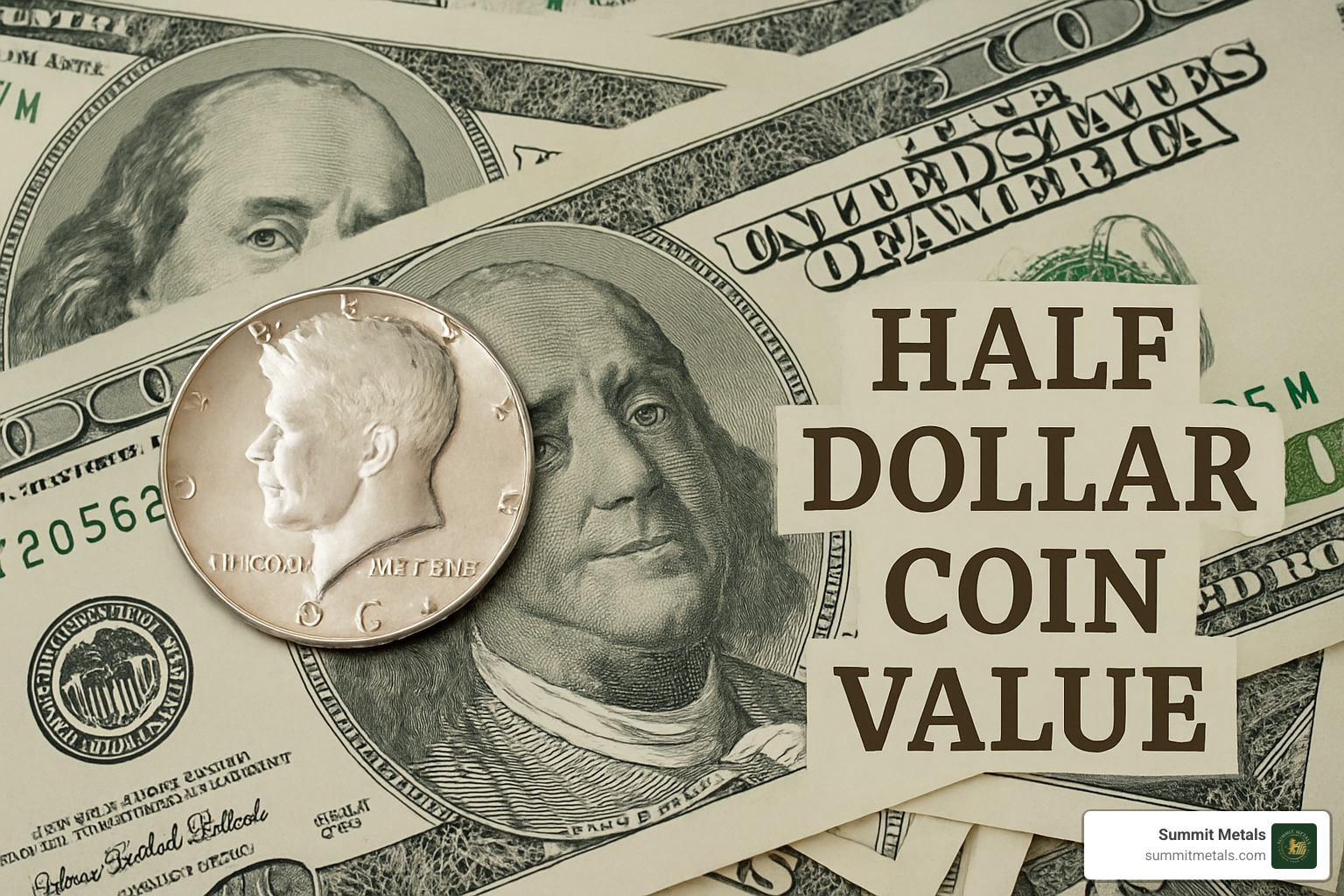
Record Setters
- 1964 Kennedy SMS SP-68: $156,000 (2019).
- 1921-S Walking Liberty MS-65: $8,300.
- 1970-D Kennedy MS-67: $13,000.
- 1971-D silver-planchet error: $10,000 +.
Everyday Ranges (typical retail)
| Type | Circulated | Choice Unc/Proof |
|---|---|---|
| 1964 Kennedy (90 %) | $10-25 | $60-300 |
| 1965-1970 Kennedy (40 %) | $3-8 | $15-80 |
| 1971-present Kennedy (clad) | $0.50-1 | Up to $40 (key dates) |
| Walking Liberty (common) | $10-25 | $30-300 |
| Franklin (common) | $12-30 | $40-200 |
| Bicentennial clad | $0.50-3 | $5-20 |
| Bicentennial 40 % silver | $6-15 | $20-100 |
Silver provides the floor; rarity and condition create the ceiling. Check both before you sell—or you could leave serious money on the table.
Frequently Asked Questions about Half Dollar Coin Value
How can I tell if my half dollar is valuable?
Start with the date. Anything 1964 or earlier is 90 % silver, worth $10-15 + in melt. Next, look for 1965-1970 (40 % silver) or key dates such as 1921-S or 1970-D. Finally, check condition and hunt for obvious errors—those can dwarf silver value.
Where is the mint mark and what does it mean?
Below Kennedy’s neck in 1964; above the date from 1968 forward.
- No mark: Philadelphia
- D: Denver
- S: San Francisco (often proofs)
Lower-mintage mints—especially Denver in 1970—push prices higher.
Are all half dollars silver?
No.
- 1794-1964: 90 % silver
- 1965-1970: 40 % silver
- 1971-present: clad, unless struck for special silver collector sets
The edge test—solid silver vs. copper stripe—is the fastest way to confirm.
Conclusion
Knowing the basics—date, mint mark, silver content, and condition—turns guessing into real valuation. That quick check often reveals an under-appreciated asset instead of ordinary change.
Summit Metals, headquartered in Wyoming, buys and sells authenticated gold and silver at live, transparent prices. When you’re ready to turn half-dollar finds into portfolio metal—or upgrade to professionally graded examples—our team can help.
Market prices will keep moving, but knowledge keeps its value. Take a fresh look at those half-dollars; your next significant find might be sitting in a desk drawer right now.
